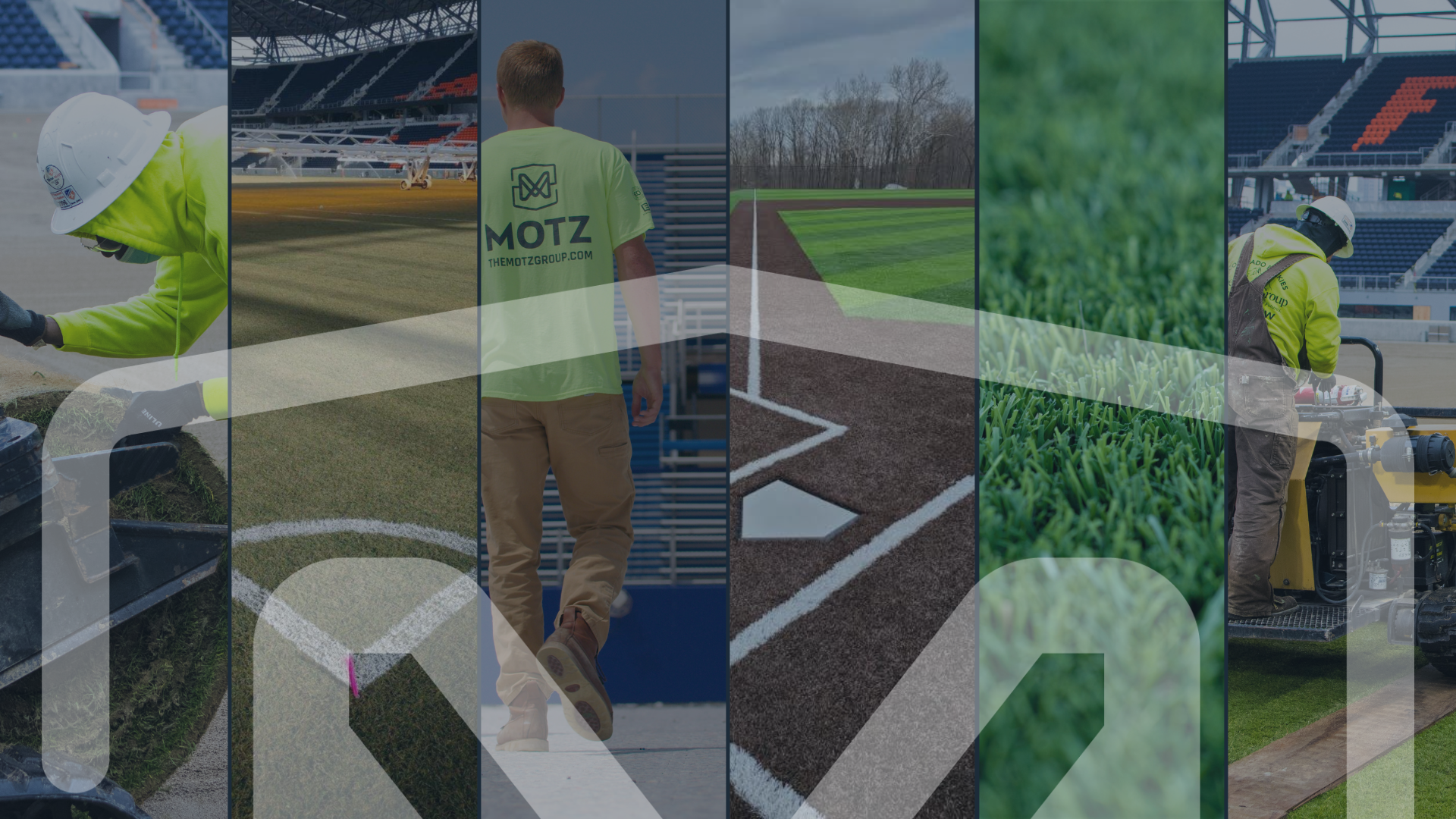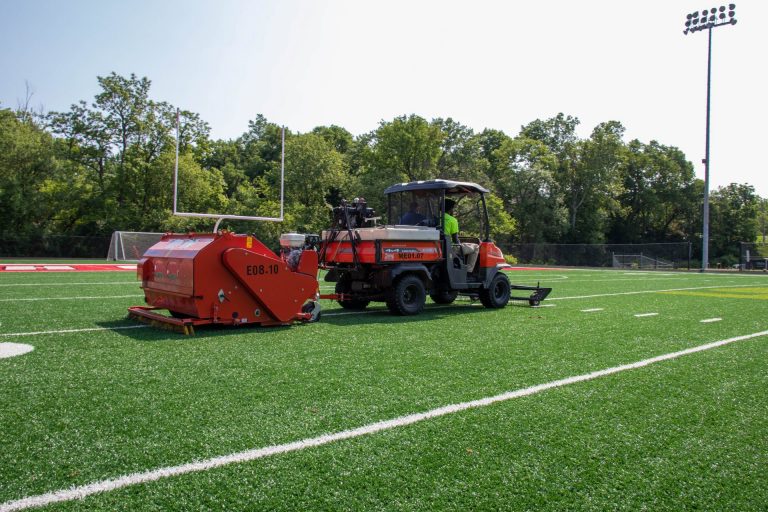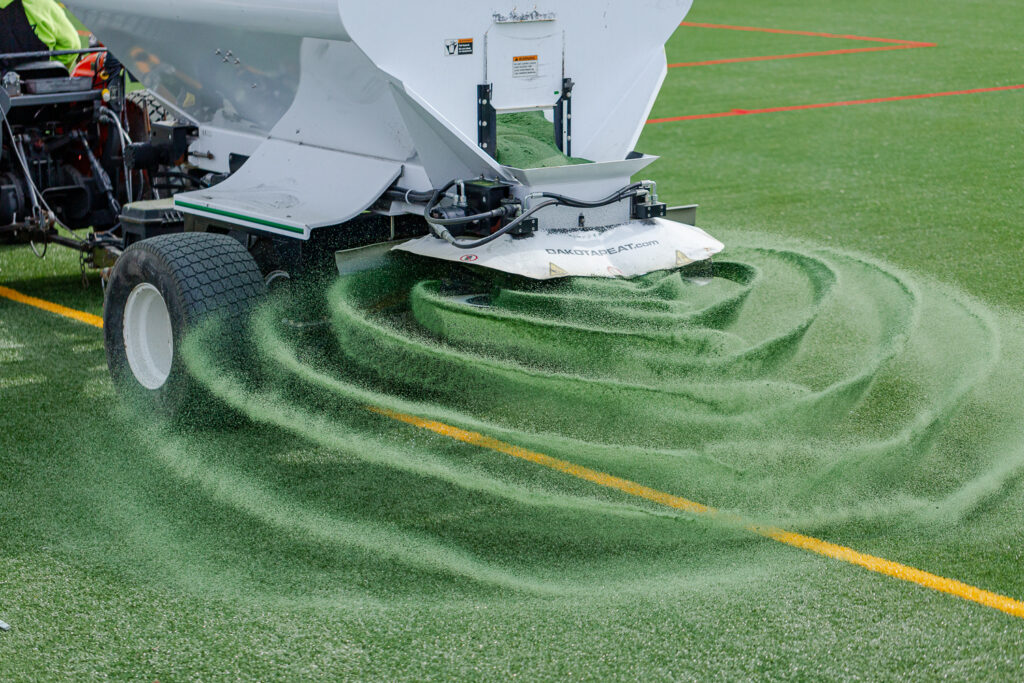
Sports Field Blog
Subscribe To Email Updates
Subscribe to our weekly newsletter and we’ll send updates straight to your inbox
Athletic Turf Field Maintenance Checklist: Tips, Techniques, and Equipment For Your Staff
No matter the season or sport you’re in right now, maintenance is the name of the game. And, as any good athletic director knows all too well, the tools, equipment, and techniques used to maintain your synthetic turf field are critical to the process. At Motz, we are dedicated to helping you maintain your field 365 days a year to keep you ready for play. We’ve put the time and research into developing the ultimate playbook for your field maintenance staff and today, we’re sharing these insights with you.
Read on to get pro turf field maintenance tips, techniques and equipment recommendations for your staff!
TABLE OF CONTENTS
BEST PRACTICES FOR SYNTHETIC ATHLETIC TURF FIELD MAINTENANCE
Whether it’s been one week or one year since your turf installation, maintenance matters. Having a strong maintenance plan in place is the best way to keep your synthetic turf field safe and play-ready. And while each field is unique in certain ways, there are some common practices that hold true across the board. Simply put, following these three practices will help keep your field play-ready and looking brand new.
1. Define Your Long Term Goals for your Athletic Field
Why does it matter that your team follows the right care tips for your artificial turf field? The maintenance of a synthetic field is different from natural grass, but the purpose is the same. The reasoning behind cleaning and grooming your fields is centered on making your turf field last for years, and providing a consistent and safe surface for your players.
Maybe your long term goal is to decrease the overall number of athlete injuries on your turf? Or maybe it’s keeping your current turf in good shape for a minimum of 10 years? Whatever your goal(s) end up being, defining them will help you create a focused maintenance checklist for the year.
2. Create A Maintenance Routine for your Athletic Field
A synthetic turf athletic field maintenance routine is basically the same thing as a checklist. It provides you with a daily and yearly grooming and deep cleaning plan. A maintenance routine helps everyone know how to maintain the field and improves communication with the grounds team.
Additionally, having an athletic field maintenance checklist allows your field staff the opportunity to make sure your synthetic turf is operating in the best condition. It also brings awareness to any areas that may need repairs or attention. Last but not least, it helps your staff budget for the best quality products and field maintenance professionals. (If you don’t already have a printable checklist, you can get access to our FREE Athletic Field Maintenance Checklist here!)
3. Plan & Budget For A Deep Cleaning of your Athletic Field
Having a budget-backed plan along with a professional deep cleaning service gives your team the resources to repair, replace, or replenish various components of your turf system such as seams and infill. This means planning ahead for both the tasks your team can handle as well as the ones we recommend leaving to the pro’s.
Not only do you want a professional turf expert to deep clean your field, but also to test the surface to make sure it’s consistent throughout. GMAX testing and other turf tests are important to prepare for each year. These tests will measure the health of your turf in terms of shock absorption, durability, traction, and performance. Understanding these components is critical to creating a plan and a budget.
WHAT YOUR STAFF SHOULD KNOW ABOUT YOUR SYNTHETIC TURF SPORTS FIELD
Every athletic director or field maintenance manager needs a solid list of resources when it comes to onboarding, training and continued education for their team. This is because great training leads to great turf care (and great turf care leads to great games). When we talk about the key information that your staff needs to know for great turf care, we always start with the basics. That means making sure your team understands and follows through on the Motz top four maintenance tips:
- Groom your field every 40 HOURS of play or every two weeks.
- Test and deep clean your turf field yearly to maintain your high performing field surface.
- Make sure you use the proper equipment to clean your turf field.
- Do not clean or groom your sports field on game day, instead groom the turf the day before to keep infill level throughout the surface. This way, if you discover any repairs are needed, there’s adequate time for our Motz365 team to tend to those issues before the game.
If those four tasks are being taken care of, you’re already winning. Beyond that, there are always ways to up your game as well. Depending on how much action your field sees at any given time of year (how old your turf is and how well it’s been maintained annually) you will want your staff to have customized knowledge. Remember that our Motz365 Team is here to help, too, with maintenance programs and services!

SPORTS TURF FIELD MAINTENANCE EQUIPMENT TO CONSIDER
It’s true: grooming isn’t just a personal care thing. Your turf needs it too! Synthetic turf field grooming is critical to your field’s health (and thus, the health of your players). Understanding the basics of synthetic turf field grooming can help you and your team become expert trouble-shooters and prevention experts for your athletic turf. Whether you have a field in constant use throughout the year or you have the opportunity to implement a Summer turf maintenance program play-free, learn the types of brushes and basic techniques below.
Types of Brushes to Use To Groom Your Athletic Field
Grooming the surface of your synthetic turf field starts with having the correct turf maintenance equipment. You’ll want to brush your turf field regularly in order to maintain a consistent and clean surface. There are different kinds of brushes available for you to use to create a safe, clean, and high-performing field year-round. Two of the most commonly used grooming tools/brushes are a static brush and a mechanical sweeper. A static brush is used to keep the infill level and turf fibers standing up. A mechanical sweeper helps quickly and thoroughly remove debris. Both tools’ bristles need to be made from synthetic fiber to be safe for use on artificial turf.
Check out this Motz365 chart for a quick reference guide:
| Types of Synthetic Turf Equipment | Benefits of Synthetic Turf Equipment |
|---|---|
| Static Brush | Keeps in the infill level and turf fibers standing up |
| Mechanical Sweeper | Removes debris |
| Synthetic Fiber Bristles | Gentle on turf fibers but strong enough to remove debris |
SPORTS TURF MAINTENANCE TECHNIQUES
It’s important to remember that every type of artificial turf sports field must be cared for differently. Why? Because areas of high traffic impact the athlete’s performance and safety on the field (and every sport has a different area of high traffic). Having a field maintenance plan to care for these high-traffic areas is important for the durability and longevity of your sports field.
We recommend spending some time mapping out the areas of your field that would be considered high traffic. Then you will also need to know what sports field maintenance techniques are recommended for care, maintenance, and grooming in those areas. The charts below will give you an idea of where and how to start. New turf maintenance team members may benefit from taking a look at these for an easy way to remember the basics!
Maintenance Grooming for All Synthetic Turf Sports Fields
Use this chart as a reference for the primary sports field maintenance techniques.
| Sports Field Maintenance Techniques | Sports Field Maintenance Technique Description |
|---|---|
| Surface Grooming | Surface grooming is recommended every 40 hours of use or roughly once every two weeks, to maintain proper infill depth and place fibers in an upright position. |
| Infill Decompaction | When using a conventional infill system, annual infill decompaction for high-use fields is necessary. Fields with more typical levels of use will need to be decompacted every 3-4 years. |
| Proper Infill Depth | Add infill as needed to high-traffic areas to maintain proper infill depth. Proper infill level is critical to fiber performance and player safety. |
| Adding Infill | Infill can be added by hand and spread with a broom or flexible leaf rake in smaller areas or spread with a powered groomer in larger areas. |
Maintenance Guidelines for Each Type of Synthetic Turf Sports Field
Keep the following chart handy if your field is used for a variety of different sports each year.
| Sports Type | Pay Attention To These Artificial Turf Field Areas |
|---|---|
| Baseball and Softball | Batter’s Box, Catcher’s Box, Umpire’s Box, First Base Area, Second Base Area, Pitcher’s Mound, On-Deck Circles, Dugout Entrance, Coach’s Box |
| Soccer | Penalty Spot, Corner Kick, Goal Mouth, Center Circle, Face-Off Location, Linesman Paths, Entrance From Field House |
| Football | Extra Point Line, Team Sideline Areas, Entrance From Field House, Between the Hash Marks, Kick “X” |
| Lacrosse | Penalty Spot, Corner Kick, Goal Mouth, Center Circle, Face-Off Location, Linesman Paths, Entrance From Field House |
| Multi-Purpose | Penalty Spot, Corner Kick, Goal Mouth, Center Circle, Face-Off Location, Linesman Paths, Entrance From Field House, Extra Point Line, Team Sideline Areas, Entrance From Field House, Between the Hash Marks, Kick “X” |
Join Our Athletic Field Maintenance Community Today!
We hope this information helps get you and your team on the same page about athletic turf field care. These tips and standard turf maintenance practices can help improve the safety of your players and lengthen how long your synthetic turf field will last.
For more technical care steps or information about Motz365 Field Aide and Track Aide maintenance packages, fill out a maintenance information form. For ongoing pro tips, resources and tricks, sign up for our Field Aide Newsletter and check out our sports field blog to discover more details about sports field maintenance care.
Similar Blogs



